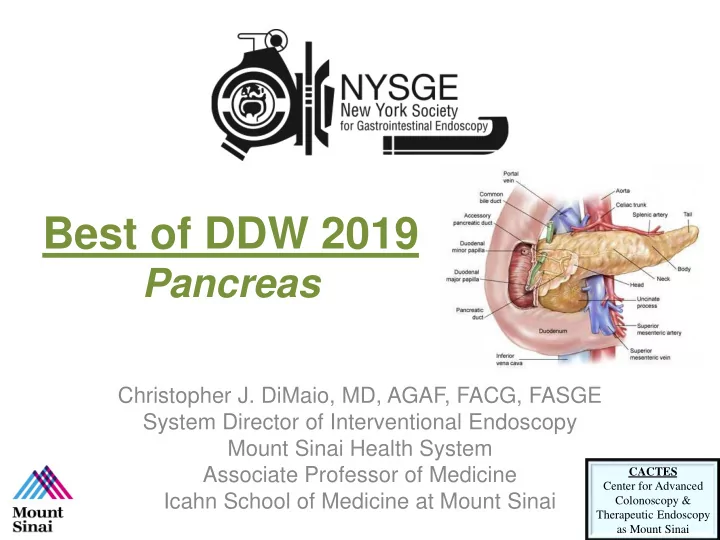

Best of DDW 2019 Pancreas Christopher J. DiMaio, MD, AGAF, FACG, FASGE System Director of Interventional Endoscopy Mount Sinai Health System Associate Professor of Medicine CACTES Center for Advanced Icahn School of Medicine at Mount Sinai Colonoscopy & Therapeutic Endoscopy as Mount Sinai
Agenda • Acute pancreatitis • Pancreatic cysts • EUS-guided therapy
Acute Pancreatitis
THE CLINICAL COURSE AND DIAGNOSTIC WORK-UP OF IDIOPATHIC ACUTE PANCREATITIS, A POST-HOC ANALYSIS OF A PROSPECTIVE MULTICENTER OBSERVATIONAL COHORT AuthorBlock: Nora D. Hallensleben 1,2 , Devica S. Umans 3,2 , Stefan A.W. Bouwense 4 , Robert C. Verdonk 2 , Marc Besselink 3 , Jeanin E. Van Hooft 3 , Marco J. Bruno 1 1 Gastroenterology & Hepatology, Erasmus Medical Centre, Rotterdam, Netherlands; 2 Gastroenterology, St. Antonius Hospital, Nieuwegein, Netherlands; 3 Amsterdam Medical Centres, location AMC, Amsterdam, Netherlands; 4 Surgery, Radboud umc, Nijmegen, Netherlands; • After standard diagnostic work-up, the etiology of acute pancreatitis remains unknown in up to 25% of cases, a condition referred to as idiopathic acute pancreatitis (IAP). • Determining the etiology of pancreatitis is essential, as it may direct treatment in the acute phase of the disease and guide interventions to prevent recurrent pancreatitis. • AIM - Explore the use of additional diagnostic modalities and their diagnostic yield to identify underlying etiologies in “presumed” IAP
Work-Up of Idiopathic Acute Pancreatitis • Between 2008 and 2015, patients with acute pancreatitis were registered prospectively in 15 Dutch hospitals. • Patients who initially had a negative diagnostic work-up with regard to the etiology of their first episode of pancreatitis were labelled IAP. • This initial work-up included: – personal history, family history, trans abdominal ultrasound, and laboratory tests (i.e. liver enzymes, calcium, triglycerides). • Post-hoc analysis including the type and number of all additional diagnostic tests performed, the yield of these test to establish an etiological diagnosis, and recurrence rates of IAP.
Pancreatic Cysts
Differential Diagnosis Pancreatic Cyst Non- Mucinous Mucinous Serous IPMN I nflammatory MCN Other Cystic Ductal Adenocarcinoma Cystic Neuroendocrine Tumor Solid Pseudo-Papillary Tumor
Limitations of Current Diagnostic Testing in Distinguishing Pancreatic Cystic Neoplasms (Mucinous vs Non-Mucinous) Accuracy Differentiate cyst type Contrast-enhanced CT 39-44.7% MRI/MRCP* 39.5-50% *MRCP has high sensitivity 96% for BD-IPMN Sensitivity Specificity Differentiate cyst type Cyst fluid CEA level 63% 93% Cyst fluid cytology 54-67% 88-93% Jones MJ, et al. Pancreatology 2013 Tirkes T, et al. Abdom Imag 2014 de Jong K, et al. Endoscopy 2011 Thosani N, et al. Dig Dis Sci 2010 Thornton GD, et al. Pancreatology 2013 Ngamruengphong S, et al. Dig Liver Dis 2014 Suzuki R, et al. Pancreatology 2014
Needle-Based Confocal Laser Endomicroscopy (nCLE) Konda VJ, et al. Endoscopy 2013. Napolean B, et al. Endoscopy 2015.
Through-The-Needle Microforceps IPMN w/LGD (gastric type)
EUS-GUIDED MICROFORCEPS BIOPSY AND NEEDLE-BASED CONFOCAL LASER ENDOMICROSCOPY SIGNIFICANTLY IMPROVE THE DIAGNOSTIC YIELD AND HAVE MAJOR IMPACT ON CLINICAL MANAGEMENT OF PANCREATIC CYSTIC LESIONS Authors: Antonio R. Cheesman, MD 1 , Hongfa Zhu, MD, PhD 2 , Nikhil A. Kumta, MD, MS 1 , Satish Nagula, MD 1 , Christopher J. DiMaio, MD 1
Diagnostic yield of FNA cytology, current standard, MFB and nCLE for PCLs p ≤ 0.05 p ≤ 0.05 Cytology CS = Current standard
Diagnostic yield of FNA cytology, current standard, MFB and nCLE for PCLs p ≤ 0.05 p ≤ 0.05 Cytology CS = Current standard
Clinical management of patient cohort based on current standard vs. MFB, nCLE and MFB/nCLE Overall ∆ in clinical management compared to CS: MFB 38.6 %, nCLE 43.2 %, MFB + nCLE 52.3 % CS = Current standard
Conclusions ❖ Use of combined EUS-guided FNA, MFB and nCLE appears safe ❖ Diagnostic yield: Current evaluation of PCLs including EUS-FNA is suboptimal (34.1 %) ▪ Significant improvement with use of adjunct MFB (79.5 %) or nCLE (88.6 %) ▪ No significant difference between either of these ▪ ❖ Clinical management Significant changes in management from MFB (38.6 %) and nCLE (43.2 %) use ▪ Reclassification of indeterminate lesions → discontinuation of surveillance ▪ Consider MFB or nCLE when performing EUS-FNA of PCLs
Therapeutic EUS
Drainage of Malignant Biliary Obstruction ERCP/metal stent EUS-guided biliary drainage
Results • 5 studies with 361 patients were included in meta- analysis and systematic review • Comparable technical and clinical success in both groups. • Comparable rates of adverse outcomes and reintervention rate. • No difference in non-pancreatitis related adverse events.
Results Procedure-related pancreatitis Tumor overgrowth requiring reintervention
Conclusions • EUS can potentially be used as an alternative to ERCP as the first line palliative modality for MBO. • Larger studies are needed to assess the impact of EUS-BD in patients with resectable disease.
EUS-Guided Gallbladder Drainage
EUS-GB with LAMS
EUS-Guided Gallbladder Drainage • Hypothesis – EUS-guided gallbladder drainage (EUS-GBD) would reduce 1-year adverse events as compared to percutaneous gallbladder drainage (PT-GBD) • Aim – To compare the outcomes of EUS-GBD vs PT-GBD in treatment of acute calculous cholecystitis in patients that are very high-risk for cholecystectomy • Prospective, RCT
Pancreatic Cancer • Current therapies … – Suboptimal • Dense stroma • Poorly vascularized – Systemic toxicity • Potential solution … – Direct intra-tumoral therapy – High local concentrations – Minimize systemic toxicity
EUS-Guided Tumor Ablation
EUS-GUIDED RADIOFREQUENCY ABLATION PLUS CHEMOTHERAPY VERSUS CHEMOTHERAPY ALONE FOR UNRESECTABLE PANCREATIC CANCER (ERAP): PRELIMINARY RESULTS OF A PROSPECTIVE COMPARATIVE STUDY Pradermchai Kongkam 1,2 , Kasenee Tiankanon 1 , Arlyn R. Cañones 1 , Thanawat Luangsukrerk 1 , Dong Wan Seo 4 , Chonnipa Nantavithya 3 , Trirat Jantarattana 6 , Virote Sriuranpong 5 , Phonthep Angsuwatcharakon 1 , Wiriyaporn Ridtitid 1 , Pinit Kullavanijaya 1 , Rungsun Rerknimitr 1
Recommend
More recommend